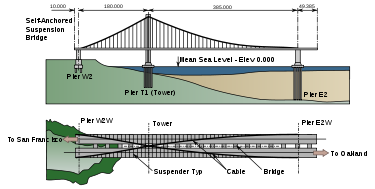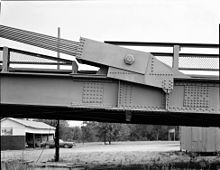
A suspension bridge is a type of bridge in which the deck is hung below suspension cables on vertical suspenders. The first modern examples of this type of bridge were built in the early 1800s. Simple suspension bridges, which lack vertical suspenders, have a long history in many mountainous parts of the world.

A cable-stayed bridge has one or more towers, from which cables support the bridge deck. A distinctive feature are the cables or stays, which run directly from the tower to the deck, normally forming a fan-like pattern or a series of parallel lines. This is in contrast to the modern suspension bridge, where the cables supporting the deck are suspended vertically from the main cable, anchored at both ends of the bridge and running between the towers. The cable-stayed bridge is optimal for spans longer than cantilever bridges and shorter than suspension bridges. This is the range within which cantilever bridges would rapidly grow heavier, and suspension bridge cabling would be more costly.

The San Francisco–Oakland Bay Bridge, known locally as the Bay Bridge, is a complex of bridges spanning San Francisco Bay in California. As part of Interstate 80 and the direct road between San Francisco and Oakland, it carries about 260,000 vehicles a day on its two decks. It has one of the longest spans in the United States.

An arch bridge is a bridge with abutments at each end shaped as a curved arch. Arch bridges work by transferring the weight of the bridge and its loads partially into a horizontal thrust restrained by the abutments at either side. A viaduct may be made from a series of arches, although other more economical structures are typically used today.
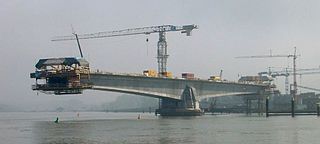
A cantilever bridge is a bridge built using structures that project horizontally into space, supported on only one end. For small footbridges, the cantilevers may be simple beams; however, large cantilever bridges designed to handle road or rail traffic use trusses built from structural steel, or box girders built from prestressed concrete.

The 25 de Abril Bridge is a suspension bridge connecting the city of Lisbon, capital of Portugal, to the municipality of Almada on the left (south) bank of the Tagus River. It has a total length of 2,277 metres (7,470 ft), making it the 46th longest suspension bridge in the world.

A simple suspension bridge is a primitive type of bridge in which the deck of the bridge lies on two parallel load-bearing cables that are anchored at either end. They have no towers or piers. The cables follow a shallow downward catenary arc which moves in response to dynamic loads on the bridge deck.

The Carquinez Bridge is a pair of parallel bridges spanning the Carquinez Strait at the northeastern end of San Francisco Bay. They form the part of Interstate 80 between Crockett and Vallejo, California.

The eastern span replacement of the San Francisco–Oakland Bay Bridge was a construction project to replace a seismically unsound portion of the Bay Bridge with a new self-anchored suspension bridge (SAS) and a pair of viaducts. The bridge is in the U.S. state of California and crosses the San Francisco Bay between Yerba Buena Island and Oakland. The span replacement took place between 2002 and 2013, and is the most expensive public works project in California history, with a final price tag of $6.5 billion, a 2,500% cost overrun from the original estimate of $250 million. Originally scheduled to open in 2007, several problems delayed the opening until September 2, 2013. With a width of 258.33 ft (78.74 m), comprising 10 general-purpose lanes, it is the world's widest bridge according to Guinness World Records.

Falsework consists of temporary structures used in construction to support a permanent structure until its construction is sufficiently advanced to support itself. For arches, this is specifically called centering. Falsework includes temporary support structures for formwork used to mold concrete in the construction of buildings, bridges, and elevated roadways.
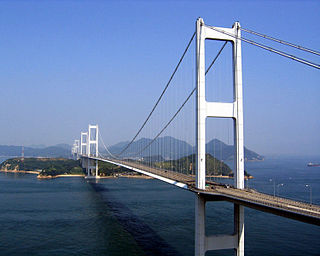
The Kurushima Kaikyō Bridge, which connects the island of Ōshima to the main part of Shikoku, was the world's longest suspension bridge structure when completed, in 1999. The bridge is part of the Shimanami Kaidō, an expressway that spans a series of islands and connects Hiroshima Prefecture in Honshū to Ehime Prefecture in Shikoku. The bridge and the expressway were both conceived by the Honshū-Shikoku Bridge Project.
A suspension bridge supports its structural load with cables, ropes, or chains anchored at each end. Cables on the earliest suspension bridges were anchored in the ground; some modern suspension bridges anchor the cables to the ends of the bridge itself. Earliest suspension bridges had no towers or piers but the majority of larger modern suspension bridges have them. All of the 14 longest bridges in the world are suspension bridges.

The Roberto Clemente Bridge, also known as the Sixth Street Bridge, spans the Allegheny River in downtown Pittsburgh, Pennsylvania, United States.
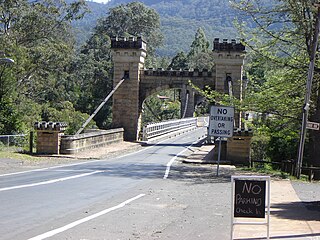
Hampden Bridge is a heritage-listed single-span suspension bridge that carries Moss Vale Road (B73) across the Kangaroo River, in Kangaroo Valley, in the City of Shoalhaven local government area of New South Wales, Australia. The bridge was designed by Ernest de Burgh and built by Loveridge and Hudson. The property is owned by Transport for NSW. It was added to the New South Wales State Heritage Register on 2 August 2019.

An extradosed bridge employs a structure that combines the main elements of both a prestressed box girder bridge and a cable-stayed bridge. The name comes from the word extrados, the exterior or upper curve of an arch, and refers to how the "stay cables" on an extradosed bridge are not considered as such in the design, but are instead treated as external prestressing tendons deviating upward from the deck. In this concept, they remain part of the main bridge superstructure.

The Konohana Bridge is a self-anchored suspension bridge located in Osaka, Japan. Opened for traffic in 1990, it has a main span of 300 metres (980 ft). The bridge's unusual design has only a single main cable. At the time of its completion it was the largest self-anchored suspension bridge in the world. Its centre span has been tied by the Yeongjong Grand Bridge in Korea which has slightly larger side spans. As of late 2012, the single tower eastern span replacement of the San Francisco – Oakland Bay Bridge has a longer span of 385 metres (1,263 ft).
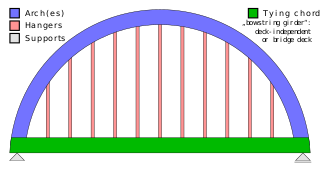
A tied-arch bridge is an arch bridge in which the outward horizontal forces of the arch(es) caused by tension at the arch ends to a foundation are countered by equal tension of its own gravity plus any element of the total deck structure such great arch(es) support. The arch(es) have strengthened chord(s) that run to a strong part of the deck structure or to independent tie-rods below the arch ends.

The Térénez bridge is a cable-stayed bridge, located between Landévennec and Rosnoën, Finistère, France.

The Port à l'Anglais Bridge is a cable-stayed suspension bridge that spans the Seine river between the French communes Alfortville and Vitry-sur-Seine. It carries two lanes of automobile traffic and has pedestrian walkways on each side.

The Long Gully Bridge, also known as Northbridge, Suspension Bridge, and Cammeray Bridge, is a concrete arch road bridge that carries Strathallen Avenue across Flat Rock Creek and Tunks Park, and connects the suburbs of Cammeray, in the North Sydney Council local government area to its south, with Northbridge in the City of Willoughby local government area to its north, in Sydney, New South Wales, Australia.




